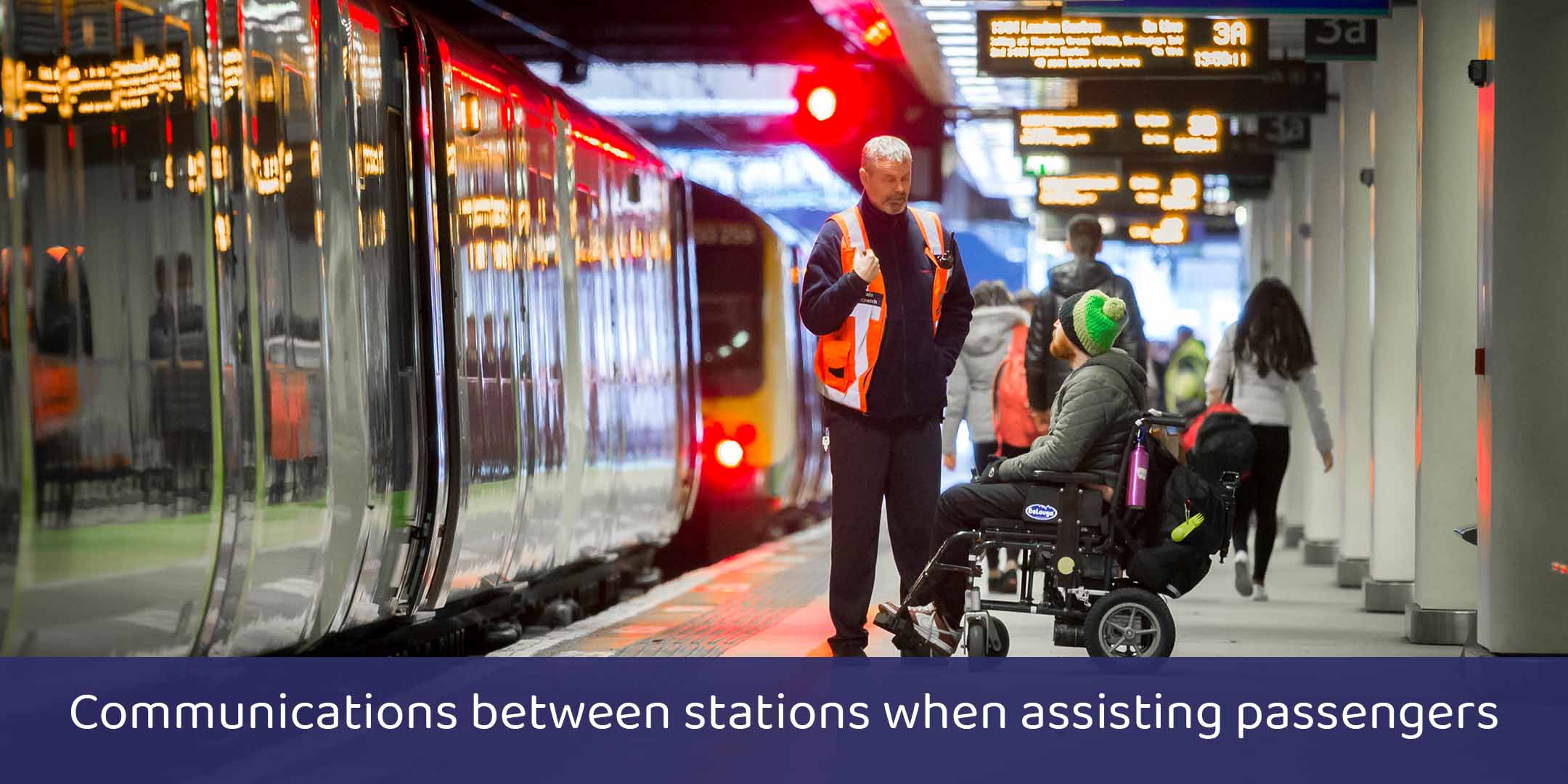Learnings from a review of the Handover Protocol at five busy stations.

In this section:
Executive summary
We want older and disabled passengers to have confidence that any assistance they need to travel by rail will be available and reliable. Our research shows that passenger satisfaction with assistance when it is delivered is relatively high, but that assistance provision is not currently reliable enough. Better communication between staff at boarding and destination stations remains a key enabler for improvement as it will help to ensure passengers who are assisted onto a train by staff will receive assistance to get off at their destination.
Under ORR’s Accessible Travel Policy Guidance, staff at the boarding station must contact staff at the destination station by phone when they assist someone onto a train, unless an alternative arrangement has been agreed with ORR. These requirements were developed by ORR in 2019. Since then, the development and rollout of the Passenger Assist staff app and web interface (dashboard) mean that many staff can communicate electronically between stations and trains to co-ordinate assistance delivery.
In 2023 ORR commissioned audits of five operators focused on regulatory requirements related to the delivery of assistance. The findings highlighted a particular risk around communications to and from busy stations at busy times. Operators’ risk management processes were also highlighted as an area that needed review. We therefore committed to further assurance work, and our findings are set out in this report.
We selected five busy stations that receive high volumes of assistance requests and where assistance is delivered by a range of train and station operators, including Network Rail. The five stations were Birmingham New Street, Bristol Temple Meads, Crewe, London Kings Cross and Manchester Piccadilly. We issued them with an information request and visited the stations. This document draws together key findings and recommendations that are of broader relevance across the industry.
Our four key findings are:
- The continued rollout of the Passenger Assist staff app and dashboard is giving staff better oversight of assistance needs, and they are invested in the benefits.
At all the stations we engaged with, staff were hugely positive about the impact of the staff app and dashboard on their ability to better meet passengers’ assistance needs on a day-to-day basis. The Passenger Assist dashboard provided stations with a real-time overview of all passengers who requested assistance and was used to match assistance staff to passengers on both inbound and outbound services. At most of the stations we visited, a dedicated coordinator managed the dashboard to reduce the risk that assistance needs would be missed. Assistance staff were able to independently manage the tasks that had been allocated to them through the staff app and could quickly and easily input the handover information needed by destination stations. - The Passenger Assist system captures data on assistance outcomes, but we did not observe this data being routinely used to monitor assistance reliability or inform improvements for passengers.
Most of the stations we visited made very limited use of the data held within the Passenger Assist system. The Passenger Assist data should be a rich source of insight for operators in investigating why failures happen and what they need to do to improve. We expected to see staff regularly reviewing outcomes both for assists that they were directly responsible for delivering, and for the onward journey of passengers that they had assisted onto trains. - Structured governance processes for considering assistance risks and outcomes help drive continuous improvement.
At those stations where managers hosted regular staff discussion forums on passenger assistance and monitored issues via a risk register on an ongoing basis, we were able to see better examples of continuous improvement actions. Where these governance processes did not exist, we had low confidence that the stations had an informed understanding of whether their assistance processes were working for passengers or what improvements were needed. - Some stations appear to be moving away from routinely making phone calls between stations to communicate assistance needs and towards electronic communications using the Passenger Assist staff app and dashboard, without sufficient planning.
We saw evidence that, as staff embrace the benefits of the Passenger Assist staff app, some are choosing to move away from making a handover phone call. We fully support the use of new technology to deliver passenger benefits, but we are concerned that an unplanned transition to new ways of working creates risks for passengers as they travel across the rail network.
To address these findings, we recommend that operators of stations that deliver high volumes of passenger assistance should by end of September 2025:
- Ensure that they have processes in place at station-level that regularly bring staff together to review data on assistance outcomes, identify causes of failure and implement action to drive continuous improvement.
- Review their approach to assistance handover considering, in particular, how using the Passenger Assist staff app and dashboard to communicate between stations can support the best outcomes for passengers who need assistance to travel.
- Where operators identify that an equivalent or better service for passengers could be secured using an alternative to a phone call for handover, they should submit a proposal to ORR for consideration.
We will continue to monitor passenger experiences of assistance through our ongoing passenger survey and engage with operators to secure improvements for passengers. We expect to see operators taking actions in response to this report that contribute to that improvement.
We will be engaging with the operators of stations that deliver the largest volumes of passenger assistance to follow-up on our recommendations. Our assumption is that, as the Passenger Assist app and electronic handover function become embedded, many operators will find that routine information is passed between stations more accurately and efficiently through the Passenger Assist system than a phone call. We want to support this transition and will ensure that our approval processes are proportionate to the risks to passengers.
Introduction
We want older and disabled passengers to have confidence that any assistance they need to travel by rail will be available and reliable. Our ongoing survey of passengers that have booked assistance shows that satisfaction with assistance when is it provided is relatively high but that the service is not reliable enough.
When assistance fails it significantly impacts the wellbeing of passengers and their overall travel experience. It may cause passengers to be delayed or prevent them from travelling altogether. In the worst-case scenarios, it can result in passengers missing their station or being left on empty trains, unable to disembark. Negative experiences of passenger assistance also discourage passengers from travelling by rail in the future.
In 2023 ORR commissioned audits of five operators focused on regulatory requirements related to the delivery of assistance. The findings highlighted a particular risk around communications to and from busy stations at busy times. Operators’ risk management processes were also highlighted as an area that needed review. We therefore committed to further assurance work, and our findings are set out in this report.
The regulatory framework
All train and station operators must establish and comply with an Accessible Travel Policy (ATP) as a condition of their licence, setting out what they will do to help disabled people use the railway. Operators must secure ORR’s approval for their ATPs, and we have issued guidance that defines minimum requirements. The ATP Guidance establishes the Handover Protocol, which defines the requirements for communications between stations when delivering passenger assistance. The Guidance also requires operators to monitor and evaluate their performance in providing services for disabled passengers and set out their plans for securing continuous improvement.
The Handover Protocol
The Handover Protocol was developed by ORR with input from operators and disabled people. It applies when assistance is to be provided by station-based staff at both the passenger’s boarding and destination station. When delivering assistance, staff from the boarding station are required to call the destination station to confirm:
- the passenger’s name if they have pre-booked assistance
- the type of assistance needed
- the train headcode (a four-digit code used to identify a particular train service)
- the passenger’s location on the train
- any other relevant information
Each station must have a dedicated phone number for assistance communications, and a responsible person assigned to receive them.
The ATP Guidance allows for operators to use an alternative technology to communicate between stations subject to demonstrating at least equivalent functionality and effectiveness of a phone call. ORR must approve the adoption of any alternative technology before it can be implemented.
To date, ORR has approved use of alternatives by four operators:
- London North Eastern Railway (LNER) use the Passenger Assist system as an alternative to a phone call for booked assistance between stations where it is responsible for delivering assistance. For more details see ORR's approval letter to LNER.
- Avanti West Coast are trialling use of the Passenger Assist system to deliver an electronic handover between three of its stations. For more details see ORR's approval letter to Avanti West Coast.
- London Overground makes and receives phone calls from a control centre, rather than between each station. For more details see ORR's approval letter to Arriva Rail London.
- Northern Trains are trialling use of the Passenger Assist system to deliver an electronic handover between four of its stations. For more details see ORR's approval letter to Northern Trains.
Passenger Assist system
Passenger Assist is the shared industry software system for logging and managing assistance requests. Under the ATP Guidance, all mainline operators, including Network Rail, must use Passenger Assist when passengers book assistance. The Rail Delivery Group (RDG) manages Passenger Assist on behalf of train and station operators.
Booking assistance
When passengers book assistance in advance of a journey, whether by phone, online or through the Passenger Assist passenger app, the booking is created in the Passenger Assist system. If a passenger requests assistance for imminent travel at the station, known as Turn Up and Go (TUAG), a booking can be created in the Passenger Assist system by staff.
Delivering assistance
Staff can view assistance bookings via the Passenger Assist web interface (which we refer to as the dashboard in this report) or staff app. The dashboard is accessed through a desktop computer at a station and provides a management tool for overseeing all passenger needs for assistance at a station.
The staff app can be made available on individual staff devices, such as mobile phones and tablets, for both station and onboard staff. It enables staff to:
- view assistance tasks that have been allocated to them
- confirm when assistance has been delivered at each stage of a journey
- enter handover information needed by the destination station and share it with them
- record if assistance has not been delivered and their understanding of why
The use of the staff app is not currently a regulatory requirement, but adoption and use expand year on year. In January 2025, 16 operators reported having rolled out the staff app to staff responsible for providing assistance.
Communications between stations
When staff enter handover information into the Passenger Assist system it is visible to staff at the destination station. However, staff at the departure station do not know if the destination station have seen the information - unless they also make a phone call.
To resolve this issue, in October 2024, RDG made an electronic handover function available that enables a destination station to electronically acknowledge that they have received the handover information. This electronic handshake is intended to provide assurance to staff at the departure station that assistance will be available at the destination. The electronic handover therefore has the potential to be an appropriate replacement for a phone call.
Operators are able to switch on the electronic handover station by station. Take-up to date is very limited, partly because operators have requested some amendments to the functionality to reflect operational needs. RDG are currently refining the electronic handover functionality in response to this feedback.
Aims of our assurance work
The aims of this work are to:
- reinforce industry’s focus on the Handover Protocol, and the central role that getting communication right plays in delivering reliable assistance
- focus on busy stations due to the risks identified in our previous audits and to make our findings more impactful given the number of passengers who rely on assistance at these stations
- gather a clearer understanding of working practices to help ORR consider proposals from operators to use alternatives to the Handover Protocol
- establish good practice and potential challenges that are of broader relevance to other stations and operators
Selected stations
The stations we selected were:
- Birmingham New Street, where all assistance is delivered by Network Rail
- Bristol Temple Meads, where all assistance is delivered by Great Western Railway (GWR)
- Crewe, where all assistance is delivered by Avanti West Coast
- London Kings Cross, where assistance is delivered by London North Eastern Railway (LNER) and Govia Thameslink Railway (GTR)
- Manchester Piccadilly, where all assistance is delivered by Network Rail
There is further background on the five stations in Annex 2.
Overall, we saw six different operational models (with different approaches at the two Network Rail stations, and two operators providing assistance at Kings Cross) and in our key observations chapter we refer to these as six operators.
Structure of report
The structure of this report is as follows:
- Key observations – highlights what we found from our information gathering phase.
- Findings – summarises the key findings following analysis of the information gathered.
- Recommendations – sets out what we expect operators to do based on the findings.
- Annex 1: Methodology – outlines how we selected the stations and carried out the review.
- Annex 2: Background on the stations – provides detail about the stations that contributed to their selection.

